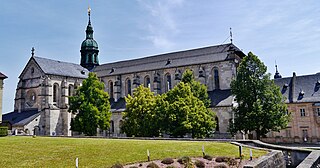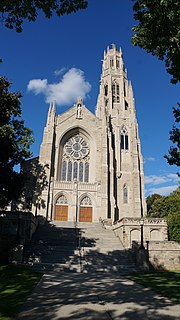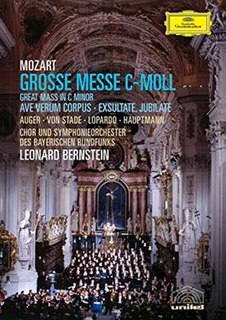
The Basilica of St. Francis Xavier is a parish church in the Archdiocese of Dubuque located in Dyersville, Iowa, United States. The church was named in honor of the missionary Saint Francis Xavier. It was raised to the status of a Minor Basilica in 1956. The church and rectory were listed together on the National Register of Historic Places in 1999.

The Basilica di Santa Maria Gloriosa dei Frari, usually just called the Frari, is a church located in the Campo dei Frari at the heart of the San Polo district of Venice, Italy. The largest church in the city, it has the status of a minor basilica. The church is dedicated to the Assumption of Mary.

Ebrach Abbey is a former Cistercian monastery in Ebrach in Oberfranken, Bavaria, Germany, now used as a young offenders' institution.

Waldsassen is a town in the district of Tirschenreuth in the Upper Palatinate region of Bavaria.

Waldsassen Abbey is a Cistercian nunnery, formerly a Cistercian monastery, located on the River Wondreb at Waldsassen near Tirschenreuth, Oberpfalz, in Bavaria, Germany, close to the border with the Czech Republic. In the Holy Roman Empire it was an Imperial Abbey.

Saint-Pierre de Montmartre is one of the oldest surviving churches in Paris, second to the Abbey of Saint-Germain-des-Pres, but the lesser known of the two main churches in Montmartre, the other being the more famous 19th-century Sacré-Cœur Basilica, just above it. Saint-Pierre de Montmartre, begun in 1133, was the church of the prestigious Montmartre Abbey, destroyed in the French Revolution.

St. Mary's Basilica – officially The Church of the Immaculate Conception of the Blessed Virgin Mary – is a church of the Roman Catholic Diocese of Phoenix located at 231 North 3rd Street at the corner of East Monroe Street in downtown Phoenix, Arizona. It was built from 1902 to 1914 in a combination of the Mission Revival and Spanish Colonial Revival styles, and was dedicated in 1915. It replaced an earlier adobe church built in 1881 when the parish was founded. The parish has been staffed by the Franciscan Friars since 1895. The current church was elevated to a minor basilica by Pope John Paul II in 1985.

The Cathedral Basilica of Christ the King is a Roman Catholic church in Hamilton, Ontario, Canada. The cathedral was consecrated on December 19, 1933. It is the seat of the Bishop of the Diocese of Hamilton, and the cathedral of the Diocese of Hamilton. The cathedral contains the cathedra of the Bishop, the Most Rev. Douglas Crosby. The cathedral was raised to the status of a minor basilica in February 2013 by Pope Benedict XVI.

The Basilica of Saint Nicholas is located in the Old Centre district of Amsterdam, Netherlands, very close to Amsterdam's main railway station. It is the city's primary Roman Catholic church.

Oliwa, Gdańsk Archcathedral is a church in Oliwa, Gdańsk, Poland that is dedicated to the Holy Trinity. Also known as the Archcathedral Basilica of the Holy Trinity in Oliwa, Gdańsk.

Fulda Cathedral is the former abbey church of Fulda Abbey and the burial place of Saint Boniface. Since 1752 it has also been the cathedral of the Diocese of Fulda, of which the Prince-Abbots of Fulda were created bishops. The abbey was dissolved in 1802 but the diocese and its cathedral have continued. The dedication is to Christ the Saviour. The cathedral constitutes the high point of the Baroque district of Fulda, and is a symbol of the town.
Günther Kaunzinger is a German organist and pianist.

Roma Church is a medieval church in Lövsta, Gotland (Sweden). The church is one of the largest countryside churches on Gotland. Built during the 13th century, it displays influences from Cistercian architecture and may have been used by Dominicans preaching for the Northern Crusades. It belongs to the Church of Sweden and lies in the Diocese of Visby.

The Basilica of the Assumption of Our Lady in Old Brno Abbey is a high Gothic, monumental convent temple. It was founded in 980-1020 by the unknown lord or monarch in Moravia. It was built on the site of an ancient sanctuary from the late 10th century in a short time in the years 1323 to 1334 at the instigation of Queen Elizabeth Richeza. It is the best preserved stylistically coherent and unified temple in Lands of Bohemian crown.

The Altenberger Dom is the former abbey church of Altenberg Abbey which was built from 1259 in Gothic style by Cistercians. Listed as a cultural heritage, it is located in Altenberg, now part of Odenthal in the Rheinisch-Bergischer Kreis, North Rhine-Westphalia, Germany. Until 1511, the church was the burial site of counts and dukes of Berg and the dukes of Jülich-Berg.

Marienstatt Abbey is a Cistercian monastery and a pilgrimage site in Streithausen, Westerwaldkreis, Rhineland-Palatinate, in the Nister valley near Hachenburg.

The Abbey of Casanova is a former Cistercian monastery located in Carmagnola, in the region of the Piedmont, Italy. The Roman Catholic church building functions in 2019 as a parish temple.

Mozart: Grosse Messe c-moll KV 427 is an 86-minute live video album of Wolfgang Amadeus Mozart's Christian vocal works Great Mass in C minor, Ave verum corpus and Exsultate, jubilate, performed by Arleen Auger, Cornelius Hauptmann, Frank Lopardo, Frederica von Stade, the Bavarian Radio Symphony Chorus and the Bavarian Radio Symphony Orchestra under the direction of Leonard Bernstein. Deutsche Grammophon issued it on VHS video cassette, Laserdisc and DVD, and also released audio cassette and CD versions of its soundtrack.

The Liebfrauenkirche in the Thuringian town of Arnstadt, Germany, is a Lutheran parish church. The basilica, which was essentially erected in the 12th and 13th centuries, is considered, along with Naumburg Cathedral, to be the most important church building of the transitional phase from Romanesque to Gothic architecture in Thuringia.

The Martinskirche is the Lutheran main church in Sindelfingen, Baden-Württemberg, Germany. It was built in Romanesque style as a basilica with a flat wooden ceiling, then part of a monastery. Today, the church is also a venue of church music events.





















